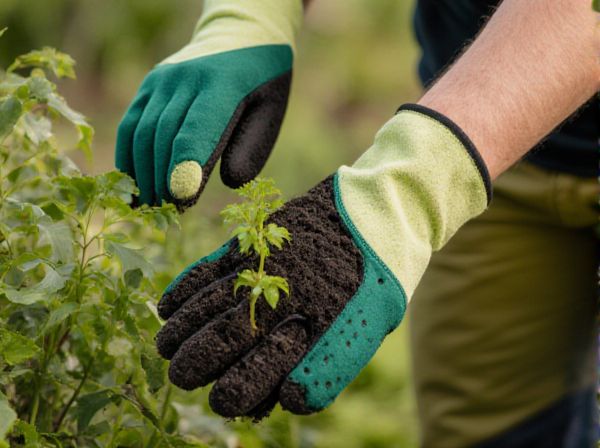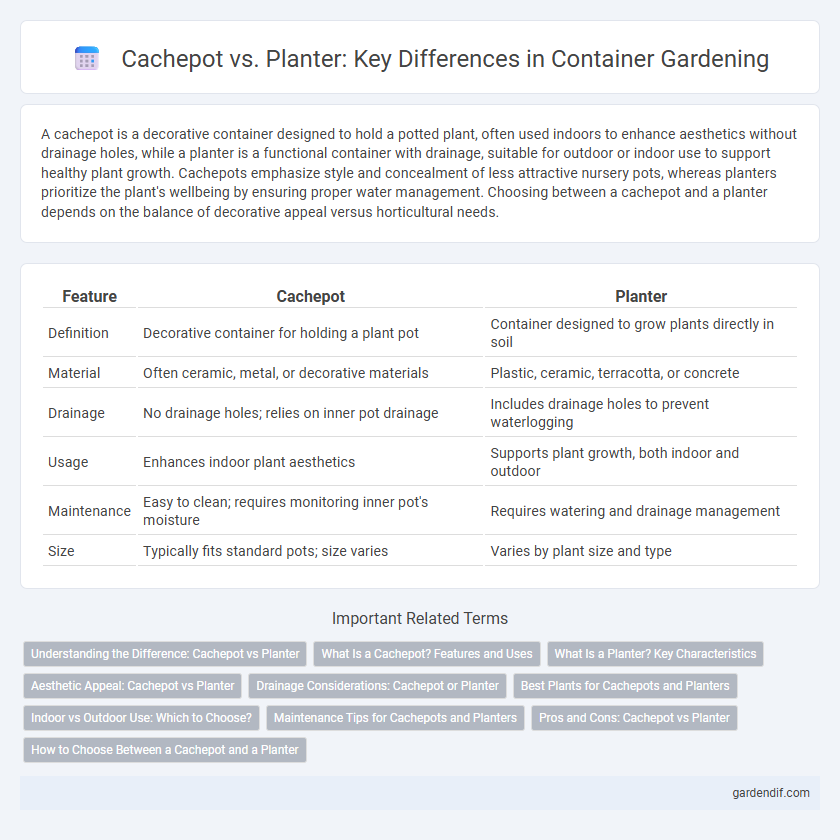
Cachepot vs Planter Illustration
A cachepot is a decorative container designed to hold a potted plant, often used indoors to enhance aesthetics without drainage holes, while a planter is a functional container with drainage, suitable for outdoor or indoor use to support healthy plant growth. Cachepots emphasize style and concealment of less attractive nursery pots, whereas planters prioritize the plant's wellbeing by ensuring proper water management. Choosing between a cachepot and a planter depends on the balance of decorative appeal versus horticultural needs.
Table of Comparison
| Feature | Cachepot | Planter |
|---|---|---|
| Definition | Decorative container for holding a plant pot | Container designed to grow plants directly in soil |
| Material | Often ceramic, metal, or decorative materials | Plastic, ceramic, terracotta, or concrete |
| Drainage | No drainage holes; relies on inner pot drainage | Includes drainage holes to prevent waterlogging |
| Usage | Enhances indoor plant aesthetics | Supports plant growth, both indoor and outdoor |
| Maintenance | Easy to clean; requires monitoring inner pot's moisture | Requires watering and drainage management |
| Size | Typically fits standard pots; size varies | Varies by plant size and type |
Understanding the Difference: Cachepot vs Planter
A cachepot is a decorative container designed to hold a plant pot, typically made from ceramic, metal, or glass, and does not have drainage holes, making it purely aesthetic. A planter, in contrast, is a functional container that usually includes drainage to support healthy root growth and prevent waterlogging when directly planting outdoors or indoors. Choosing between a cachepot and a planter depends on whether you need decorative appeal without drainage or a self-contained planting solution with proper water management.
What Is a Cachepot? Features and Uses
A cachepot is an ornamental container designed to hold a potted plant, typically without drainage holes, enhancing indoor decor by concealing a less attractive plastic or clay pot. Features include elegant materials such as ceramic, glass, or metal, and sizes that accommodate various plant types while protecting surfaces from water damage. Common uses involve housing houseplants in living spaces or offices, serving as a stylish barrier between the plant's soil and furniture.
What Is a Planter? Key Characteristics
A planter is a container designed specifically for housing and cultivating plants, often featuring drainage holes to prevent waterlogging and promote root health. Unlike decorative cachepots, planters are typically larger, more durable, and made from materials like plastic, ceramic, or terra cotta to support plant growth outdoors or indoors. The key characteristics of a planter include adequate size for root expansion, proper drainage systems, and materials that withstand environmental conditions.
Aesthetic Appeal: Cachepot vs Planter
Cachepots provide a decorative outer shell that enhances plant presentation with intricate designs and varied materials, making them ideal for indoor aesthetics. Planters, often larger and more functional, emphasize versatility and durability suitable for outdoor or garden settings while offering more space for root growth. The choice between cachepot and planter depends on balancing ornamental appeal with practical plant care needs.
Drainage Considerations: Cachepot or Planter
Cachepots typically lack drainage holes, requiring careful watering to avoid root rot, while planters often come with built-in drainage to promote healthy root aeration. Choosing a planter with adequate drainage holes helps prevent waterlogging by allowing excess moisture to escape, which is essential for most houseplants. Using a cachepot with a separate inner pot containing drainage holes can combine aesthetic appeal with functional moisture management.
Best Plants for Cachepots and Planters
Cachepots, designed as decorative outer containers without drainage holes, are ideal for tropical plants like orchids, peace lilies, and philodendrons that prefer consistent moisture levels. Planters, equipped with drainage, suit succulents, cacti, and herbs that require well-drained soil to prevent root rot. Choosing the right container ensures optimal growth by matching plant water needs with the container's drainage capabilities and aesthetic function.
Indoor vs Outdoor Use: Which to Choose?
Cachepots are primarily designed for indoor use, featuring decorative outer containers without drainage holes, making them ideal for houseplants that require controlled watering. Planters, often equipped with drainage holes and made from durable materials like terracotta or concrete, are better suited for outdoor environments where water drainage is crucial. Selecting between a cachepot and a planter depends on the plant species, watering needs, and whether the container will be placed indoors or outdoors.
Maintenance Tips for Cachepots and Planters
Cachepots and planters require regular maintenance to ensure plant health and aesthetic appeal. For cachepots, remove inner pots periodically to check for root rot and allow proper drainage, preventing waterlogging. Planters benefit from regular soil aeration and surface cleaning to avoid mold growth, along with timely fertilizer application to support plant nutrition.
Pros and Cons: Cachepot vs Planter
Cachepots offer stylish, decorative coverings for potted plants, enhancing aesthetic appeal while protecting furniture from water damage, but they typically lack drainage holes, risking root rot if used alone. Planters provide functional root space with proper drainage, promoting healthier plant growth, though they may be less visually appealing without an additional decorative cover. Choosing between cachepot and planter depends on balancing design preferences with plant care requirements.
How to Choose Between a Cachepot and a Planter
Choosing between a cachepot and a planter depends on your needs for drainage and aesthetics; planters typically have built-in drainage holes for healthy root growth, while cachepots serve as decorative outer containers without drainage. If you prefer easy plant maintenance and water control, planters are ideal, but cachepots are perfect for concealing plastic pots and enhancing indoor decor. Consider the plant type, watering habits, and design style when selecting the right container to balance function and visual appeal.
Cachepot vs Planter Infographic

 gardendif.com
gardendif.com